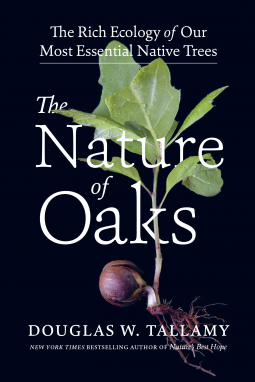
The Nature of Oaks
The Rich Ecology of Our Most Essential Native Trees
by Douglas W. Tallamy
This title was previously available on NetGalley and is now archived.
Send NetGalley books directly to your Kindle or Kindle app
1
To read on a Kindle or Kindle app, please add kindle@netgalley.com as an approved email address to receive files in your Amazon account. Click here for step-by-step instructions.
2
Also find your Kindle email address within your Amazon account, and enter it here.
Pub Date Mar 30 2021 | Archive Date Jun 21 2021
Talking about this book? Use #TheNatureofOaks #NetGalley. More hashtag tips!
Description
The Nature of Oaks reveals what is going on in oak trees month by month, highlighting the seasonal cycles of life, death, and renewal. From woodpeckers who collect and store hundreds of acorns for sustenance to the beauty of jewel caterpillars, Doug Tallamy illuminates and celebrates the wonders that occur right in our own backyards. He also shares practical advice about how to plant and care for an oak, along with information about the best oak species for your area.
The Nature of Oaks will inspire you to treasure these trees and to act to nurture and protect them.
“With our hearts and minds focused on the stewardship of the only planet we have, the best way to engage in a hopeful future is to plant oaks! Let this book be your inspiration and guide.” —The American Gardener
Available Editions
| EDITION | Other Format |
| ISBN | 9781643260440 |
| PRICE | $28.00 (USD) |
| PAGES | 200 |
Average rating from 29 members
Featured Reviews
 Rosemary S, Librarian
Rosemary S, Librarian
If anything good could come out of Covid 19, it’s our renewed interest in nature. In a world that seems out of control, nature has been a constant, soothing balm. Tallamy explores the world of the mighty oak tree, month by month, season by season. Readers learn about not only the trees, but the ecosystem of plants and animals they sustain. A fascinating and restorative read in these uncertain times
Fascinating And Easy Read. This is one of those esoteric books that you didn't know you wanted to read that turns out to be utterly fascinating... at least if you're remotely interested in caterpillars and similar insects. The narrative structure takes on each month of the year, beginning in October, and looks at what is happening within, on, under, and around an oak tree within that month - and there is quite a bit more than most probably realize. Written by an academic who studies oaks and with a particular emphasis on what he sees in the oaks within his own yard, this book is remarkably approachable and I daresay even funny - which is rare for such an academic tome. But that seems to have been at least part of the author's goal - to write a tale for the rest of us showing just why these trees are so important and the rich biodiversity they support. This is a goal the author pulled off remarkably well, and this book is very much recommended.
 Judy G S, Librarian
Judy G S, Librarian
A fascinating love letter to the Oak tree and its life. . Everyone should read this book and understand the how intertwined nature is with each other. I loved it.
Tallamy writes so confidently and convincingly that I want to go out and plant a white oak tree in my front lawn today. He succeeds in his mission to reveal that a tree is not simply a tree. It is a highly complex ecological world unto its own. His succinct and straightforward narrative was perfectly tuned for the curious observer in all of us. Learn why you shouldn't rake leaves; why rot is okay; why hungry caterpillars are not bad; and what hundreds of creatures rely upon oak trees for their livelihood.
 Reviewer 378382
Reviewer 378382
i ate through this book in an hour, and now i want to plant an oak tree. unfolds month-by-month, revealing the rich, complex ecological world sustained by these trees. i'd say it's less about oaks themselves and more about the various caterpillars (SO many caterpillars) and insects that rely on them, with a few birds thrown in for good measure, but it's still a fascinating read. i am forever convinced that we should abolish lawns, and maybe plant oak forests instead.
 Zoe K, Librarian
Zoe K, Librarian
An interesting and in-depth look at the mighty oak and all of the different ways that it provides life to those around it. Told through the months of the year, the author shares information about his own experience with growing oak trees, the devastation of oaks in North America, and the abundance of life that surrounds the oak.
 Kathleen G, Librarian
Kathleen G, Librarian
This was a fascinating read. I have always had a special place in my heart for oak trees, but after reading this book I love them even more. I didn't know how much activity I was missing by not looking closely into my oak trees. Although I will probably still not look closely into my trees, at least I can look at them, watch them grow, and think about the enormous amount of life they host. I will no longer be ignorant of the vital role oaks play in our ecosystem.
The mighty oak is the favourite of so many people but most know so little about them. They grow poorly in my area of Canada (we only have the hardy burr oak which only grows in urban microclimates) but thankfully several species grow all over in my second home country in Europe so I get to enjoy them thoroughly part of the year. Well, pre covid. The information in this book blew my mind! It is even more fascinating than I had imagined it would be. The author details what is in "season" regarding the oaks each month. Brilliant concept.
Amongst the topics are the growth of the oak tree itself, its acorns, what eats these protein-rich acorns, the benefits of the rich organic matter resulting from fallen leaves, the curious processes of masting and marcescence, gall formation, pollination, birds and other critters which rely on it and loads more. I had no idea that so many species of caterpillars develop in oak trees. Hundreds, even in winter! Not sure how many survive our -40C temperatures here but chickadees and nuthatches do quite well. Amongst the most intriguing creatures I learned about in this book are the jewel caterpillar, filament bearer, great purple hairstreak and the spun glass slug moth. Wow! The most practical information I learned is the impact of mistletoe as it grows thickly on our oaks.
The author also lists species which grow in different states in America as well as how to plant oaks.
My sincere thank you to Timber Press and NetGalley for the privilege of reading this wonderful book! I enjoyed it very much.
 Misti L, Reviewer
Misti L, Reviewer
What a fantastic book! And a book that is sorely needed! I appreciated the perspective Dr. Tallamy shared through the months of the years as well as highlighting the diverse array of insect species that utilize oaks for their existence. A must have on the library shelves for any naturalist and gardener!
From the oaks in his backyard to the many species of oaks in North America, the author tells us of the myriad of insect species these trees support - and from the insects the birdlife is supported.
If you don't want to know about or see insects, larvae and parasitoids, this is not the book for you. If you're willing to be interested, the many wonderful colour photos in my ARC will instil a respect in you for the volume and variety of species an oak can support.
The author explains many facets of oak trees through a year. The brown leaves are not shed low on the tree, especially on young trees. The dry leaves protect a little against browsing animals, also sheltering the buds from frost. Fallen leaves, which his father once raked and burnt, actually help trap water and provide a home for insects and a litter for fertiliser. Gall wasps lay eggs in leaves and twigs, protected by a hard gall which the tree obligingly grows. Why does the tree put up with this larva pest? If the larvae had to keep moving they would probably damage cells and stem structures as they ate.
Small birds fly through and forage over winter, picking off invisible insects such as overwintering caterpillars. As oaks live so long, a single tree is a massive milestone in the landscape, a place to feed for migrant and wintering and nesting birds. And prior to humans eliminating the massive herbivores, the oak canopy would have been broken up by browsing and scratching activities, so far more biodiversity would exist in a mosaic of woodlands.
If you are interested in studying forestry, ecology, trees or insects, this will be a hugely important book to read - particularly if you live in North America which I do not. I don't have all these kinds of oak. But this book gives me a good feel for them, and warns of imported plants, insects or other animals which, devoid of predators, devour unstoppably. I find it easy enough to read, but I do already know something about trees and ecology. For the nervous, I will add that it's packed with interesting anecdotes rather than graphs, so it doesn't come across as a textbook. Most terms are explained in the text, but we can also Google new words.
References on P. 160 - 162, followed by How to plant an oak. That and a list of oaks go to P. 185. Index P. 186 - 197. As the references are given with first initial, I am unable to tell how many items were by women.
I downloaded this e-ARC from Net Galley. This is an unbiased review.
 Teri P, Librarian
Teri P, Librarian
“The Nature of Oaks,” is an intelligent and thoughtful ode to Oak trees. The author discusses the many benefits of having and planting oak trees. The author is an entomologist and spends time discussing the numerous insects and birds that live, die and adventure in oak trees. Well written and enjoyable to read.
**I received an electronic ARC from NetGalley in exchange for a fair and unbiased review of this book.
 Reviewer 773240
Reviewer 773240
In his prologue, Tallamy writes that “oaks support more forms of life and more fascinating interactions than any other tree genus in North America. All this life does not show up at the same time nor stay with your oak the entire year. ... To fully appreciate what an oak tree can bring to your yard, and into your life if you are willing, we need to follow what is happening on your oak trees month by month through all four seasons.” [12] As such, the book is organized with chapters month by month, beginning with October (which is when he began writing); each chapter details some of the animal and insect life that might be active in that month and includes the author’s observations of his own yard.
I read this book in March, and I live on a street with many oak trees. I grew up with a backyard full of oak trees, watching the squirrels and birds year round, so oak trees are definitely both familiar and special to me. Tallamy has done a wonderful job of conveying how oaks are not just trees, but really entire communities comprised not only of oaks themselves but of insects, birds, and other species that live on and around them. The book includes so many interesting facts, and is simultaneously clearly well researched – with ample scientific terms and names – and very accessibly written. A bibliography is included, as well as a few useful appendices on North American oak species and how to select an oak and plant it.
It is worth mentioning that the book is very much focused on the United States – while there are hundreds of species of oak found on many continents, The Nature of Oaks only really discusses oak trees in US context. Despite knowing that some of the species discussed in the book are likely not found in my region – the middle of Ontario – I enjoyed learning about oaks and their roles in their broader ecosystems. I can definitely imagine buying this book for someone who likes birdwatching, observing insects, or gardening.
Densely informative (that’s a compliment!) an enjoyable read for the horticultural enthusiast. I am a gardener by trade, with a focus on native plants, so this book was right in my area of interest and field of study. I would recommend to any gardeners, horticultural professionals or readers with an interest in the natural world.
Thank you so much NetGalley, Douglas W. Tallamy, and Timber Press for the opportunity to read this book!
My husband and I recently purchased an acre in the mountains in Southern California. We have plans to build a home and get further away from the city. This property is covered with oak trees. Specifically, Coastal Live Oaks and Interior Live Oaks. So I was overjoyed to get approved for The Nature of Oaks by Douglas W. Tallamy. I have heard so much about his work and actually have many more of his books on my shelf! But since I will be living among the oak trees, I thought it would be best to learn more about them. This book is broken up into each month with a glimpse of what to expect from your oak trees. Most importantly, what creatures to see throughout the year. Oaks sustain so much life, from the smallest of insects to gray squirrels, to bears. I can attest to this. While visiting our property, I saw a creature that was the size of a small dog. It was a gray squirrel, but the BIGGEST gray squirrel I have ever seen! It clearly enjoys the feast!
Not only does this book go onto describe the creature but also about the pressing reasons we need to conserve these vital trees.
“Alarming headlines from around the world are reminding us of the critical linkage between plants and insects; we have removed more than half of the forests on earth and, not surprisingly, insect populations have declined globally by at least 45% since 1979. And again, it should be no surprise that with insect declines come bird declines. There are now 3 billion fewer birds in North America than there were 50 years ago, and over 430 bird species in North America are declining so rapidly that they are now considered at risk for extinction.”
THE NATURE OF OAKS
Conservation is so important and I plan on taking all his advice. I also plan to purchase this book for future reference! I was approved for this book 2 days before my father passed and it was a book that I was so excited to tell him about as he loved trees and nature as well. For this reason, this book hit me emotionally as well. I rate this book 5 out of 5 stars.
 Kim C, Educator
Kim C, Educator
Oak trees are common where I live, and they are one of the most amazing species of trees. According to this book, they support a wide variety of kinds of life. Everything from insects to fungi and mammals. I’ve always loved Douglas Tallamy’s books and this one is right up there with the best of his writing.
I love that Tallamy emphasizes how our own use of native plants can help wildlife. The oak tree is native to most places in the U.S., so it makes a good choice for a native tree for a garden. The species that use oaks are immense! This book goes into detail about some of them, but there are far more than can be shown in a single volume. It’s amazing how much life there can be on one oak tree!
The book follows a single year in the life of an oak in the author’s yard. He begins with the Fall and goes month by month, talking about the biology of some of the species that live on his oak. It’s fascinating reading.
My favorite chapter had to do with galls. I’ve been fascinated by galls for many years and love reading about them. Tallamy does not disappoint! The chapter on galls was interesting and full of details. The gall-makers have such complex relationships with their host plants, and there are so many of them! The galls on oaks are some of my favorites because of their complexity and their many forms.
The author’s writing style is very easy to read, and his accounts don’t require an advanced degree in science to understand. It is very approachable and understandable for any audience. There is a handy list at the end of the book of oak species by region. (U.S. regions only though.)
If you love natural history or trees, I highly recommend this incredible book. You will find it hard to put down!
I confess, when the beautiful foliage of autumn lights up the landscape, I always spurned the oak for its dismal display of old brown leaves. Since reading The Nature of Oaks, I have an entirely different opinion of this stalwart tree. Complete with excellent photographs, this journal of a year in the life of an oak shows us month by month the valuable contribution this native plant makes to our natural world. Entry after entry we see the way Nature connects through plants, insects, birds and mammals. This is a dramatic well-written demonstration of the web of life. I hope this book gets the audience it deserves. And having read an article by the author in The NY Times, and the comments posted there by readers, I am confident that the word is getting out. Plant an oak and save the world!
 Kaye T, Reviewer
Kaye T, Reviewer
A wonderful month by month view of the mighty oak and those that benefit from it. Birds and insects plus others, including us. Especially found it interesting about the high number of caterpillars and then moths and butterflies. An interesting looks at the seasonal views. Would recommend.
I like this book enough that I've pre-ordered it after reading this ebook, courtesy of Netgalley. I want to keep it around as a reference book so I always know what's going on with the oaks in the park down the street from me. The Nature of Oaks lets you know what's happening in and around oaks month by month.
Oaks are the best tree you can plant to attract the most wildlife from birds to mammals Blue Jays are so adapted to eating acorns that they have a little hook on their beak designed to pop open these nuts. Oaks feed hundreds of different caterpillars. You may think you don't want hundreds of squiggly things around, but these nutritious protein-filled wigglers attract and support birds. Chicks in nests need protein to grow. No other tree provides more for birds than oaks.
Mr. Tallamy is conversational and easy to understand. I want to plant some oak trees in my yard now, right now!
 Reviewer 603622
Reviewer 603622
A very informative read. It's divided up by months of the year and talks about what is happening with the insects, fungi, and birds that depend on the oak in each month. I was hoping for more information about the oak tree itself, but it was still an interesting read. There's a lot of pictures for people hoping to identify the insects mentioned.
Everyone should read this book about oak trees. Not just people interested in trees. Why? Because the author presents a comprehensive look at the important role oak trees play in a healthy ecosystem, He explains the many benefits of oak trees and highlights that short-sightedness of people who cut them down because the consider them messy. Oak trees provide food and shelter for invertebrates, mammals, birds, and more! The author knowledge and passion for the subject shines through in this well written book. Highly recommended read... especially for naturalist, students and conservation-minded people.
 Jennifer S, Bookseller
Jennifer S, Bookseller
This book is absolutely FASCINATING. If you are a resident of North America and love nature and want to protect the environment, then this is a VERY good book to give you some very good ideas on how to do that.
The cover is GORGEOUS and the pictures inside are JUST as beautiful.
And then there is the information...wow, I had NO IDEA oak trees were so important to the environment in North America. The amount of species that are specialized and literally can't live without oak trees is impressive.
This book comes with a warning, the typical one I give for all nature books. This book will make you hate humanity and how we seem to only be good at killing things. It will enrage you. Especially if you know anyone who has blithely cut down a majestic oak tree because "it's putting the wires on the house in danger with it's branches and it's cheaper and less trouble to take the tree down than to maintain the tree in a sustainable manner". (Speaking from bitter experience here. But I digress.)
This book not only breaks down the life of an oak tree month by month, detailing all of the life that thrives around said tree, at the end of the book there are practical ways we can make the world and the environment a little bit better, and it doesn't take scads of money, just some thoughtfulness and time.
Seriously, this book is a must read if you love the environment and live in North America (oaks are native in North America, not trying to eliminate a huge majority of the planet, though if you don't live here, it wouldn't hurt to read this book. The information is fascinating and the pictures are gorgeous.)
The book is slightly depressing, but it has hope at the end and the hope is the reader themselves. What can we do? We can plant a tree! Well, planting a grove of trees, three or more, is better than just one, as when you plant them together at an appropriate distance, their roots interlock and they are much stronger than just one tree and can withstand very severe weather better than just one tree.
Also, DON'T RAKE the leaves! There is a WHOLE ECOSYSTEM that relies on the leaf litter under the trees when the leaves fall. So, instead, plant other appropriate vegetation under the trees so the leaf litter is able to stay where it falls and the neighborhood won't be upset that you aren't raking and your place looks messy. Win-win!
I HIGHLY recommend this book. It is, unfortunately, necessary now, because yeah, only have one planet and kind of need to keep it going or we won't last much longer. 5, I had NO idea oaks were so darn amazing, stars!
My thanks to NetGalley and Timber Press for an eARC copy of this book to read and review.
 Michele T, Librarian
Michele T, Librarian
The Nature of Oaks is a an extremely detailed year in the life of an oak tree. Month by month snippets of the tree's biological processes are shared in addition to all of the life (predominantly but not exclusively insect) that relies on the oak. It highlights ecological webs in their tightest most complete form. Despite the topic, it was not dry or difficult to understand the minutiae but rather quite readable. It was perfect cabin reading after a day in the woods!
If you are looking for a book about oaks, this is the one. Not only was this book full of great information about oaks, but about the greater ecology as well. The cyclical month-by-month perspective was such a great presentation. I found this book to be one of those rare science books that's written in an engaging and entertaining way, but still gets the facts across. I already loved oaks and this book made me love them even more!
 Jillian F, Reviewer
Jillian F, Reviewer
Thanks to Netgalley and the publisher for the early copy of this one in exchange for a review.
I enjoyed Doug Tallamy’s other books so thought I’d check this one out. This was a very interesting book about oak trees and their role in your yard and the ecosystem as a whole. It went by month talking about what goes on with the tree each month.
I wish it had included more info on specific types of oaks but overall some good information on oaks.
Readers who liked this book also liked:
Created by Hayao Miyazaki
Comics, Graphic Novels, Manga
A Film by Hayao Miyazaki
Children's Fiction, Comics, Graphic Novels, Manga


















